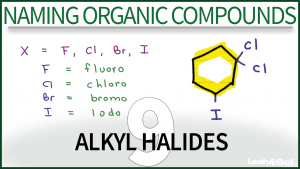 Naming Organic Compounds Series: Video 9
Naming Organic Compounds Series: Video 9
The Naming Alkyl Halides tutorial video takes you through my puzzle piece approach to IUPAC Nomenclature for compounds containing the halogens F, Cl, Br and I. Examples include simple and substituted alkyl halides, along with halogenated alkenes and cyclic compounds.
(Watch on YouTube: Alkyl Halides. Click CC on bottom right for transcript.)
<– Watch Previous Video: Naming Enynes (alkene + alkyne on same compound)
–> Watch Next Video: Naming Alcohols
This is Video 9 in the Naming Organic Compounds Video Series. Click HERE for the entire series.
Need a review on Functional Groups? Watch the Functional Groups Video, Download the Cheat Sheet, then try the Quiz.


